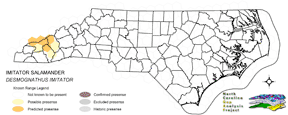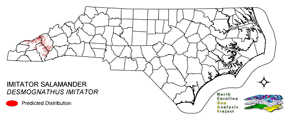|
| | | | | | | | | | |
 |
| |
|
Imitator salamander
|
|
| Desmognathus imitator
|
| |
| ITIS Species Code: 173639
NatureServ Element Code: AAAAD03050
|
|
| |
| |
Amphibia | | Caudata | | Plethodontidae
|
| | NatureServe Global Rank: | |
NatureServe State (NC) Rank: | | |
| | | Federal Status: | |
NC State Status: | | |
| |
|
|
|
| |
| HEXAGONAL KNOWN RANGE: | PREDICTED DISTRIBUTION: |
 |
 |
|
|
|
| |
| SUMMARY OF STATEWIDE PREDICTED DISTRIBUTION: |
| | | | Land Unit |
| | US Fish & Wildlife Service | | US Forest Service | | US National Park Service
| | US Department of Defense | | NC State Parks | |
NC University System | | NC Wildlife Res. Com. | | NC Forest Service | |
NC Div. of Coastal Mgmt. | | Local Governments | | Non-Governmental Org. | |
Other Public Lands | | Private Lands |
| | GAP Status 1-2
| | All Protected Lands | | Statewide |
|
| | | Hectares |
| |
0.00 | | 14,633.73 | | 0.00 | |
30,936.42 | | 0.00 | | 0.00 | |
408.15 | | 0.00 | | 0.00 | |
0.00 | | 197.37 | | 0.00 | |
22,672.80 |
| | 34,509.51 | | 46,175.67
| | 68,848.47
| | | | | Acres |
| |
0.00 | | 36,160.73 | | 0.00 | |
76,445.54 | | 0.00 | | 0.00 | |
1,008.56 | | 0.00 | | 0.00 | |
0.00 | | 487.71 | | 0.00 | |
56,025.70 |
| | 85,274.84 | | 114,102.54
| | 170,128.24
|
| | % of Dist. on |
| Prot. Lands |
| |
0.0 % | | 31.7 % | |
0.0 % | | 67.0 % | |
0.0 % | | 0.0 % | |
0.9 % | | 0.0 % | |
0.0 % | | 0.4 % | |
0.4 % | | 0.0 % | |
0.0 % |
| | 74.7
% | | ----- | | ----- |
|
| % of Dist. on | | All Lands |
| |
0.0 % | | 21.3 % | |
0.0 % | | 44.9 % | |
0.0 % | | 0.0 % | |
0.6 % | | 0.0 % | |
0.0 % | | 0.0 % | |
0.3 % | | 0.0 % | |
32.9 % |
| | 50.1
% | | ----- | | ----- |
|
|
|
|
|
|
|
|
|
|
| |
| HABITAT DESCRIPTION: |
| |
This salamander is endemic to Great Smoky mountains of Tennessee and North Carolina, with populations possibly occurring in the neighboring Plott Balsam mountains in North Carolina (Petranka 1998). Found primarily in cool, moist, mid to high elevation hardwood and red spruce-Fraser fir forests, these salamanders will occupy borders of seeps and
springs, as well as the moist forest floor and wet rock surfaces in the vicinity of streams (Petranka 1998). Intermittent stream heads and moist cove reaches just above permanent streams are also suitable as habitat (Martof et al. 1980). NATURE SERVE GLOBAL HABITAT COMMENTS: In small streams and seepage areas, in leaf litter, and under
surface objects on floor of cool, moist, red spruce- Fraser fir and hardwood forests. Also on wet rock faces.
|
|
| |
| MODELING DESCRIPTION: |
| Occupied Landcover Map Units: |
| | Code |
Name | Description |
NC Natural Heritage Program Equivalent |
| 517 | Hemlock Floodplain Forest
|
Alluvial forest with hemlock and/or white pine in mountains and western piedmont. Hydrology is generally temporarily to seasonally flooded.
|
Canada Hemlock Forest
|
| 521 | Spruce/Fir Forest
|
High Elevation Frazer-Fir - Red Spruce, Red Spruce and Red-Spruce-Yellow Birch Forests. Tree densities included here include both woodland to forest density. Highly intermixed with Northern Hardwoods, Grassy Balds, and Shrub Balds.
|
Red Spruce--Fraser Fir Forest, Fraser Fir Forest
|
| 526 | Appalachian Cove Forest
|
Mixed Mesophytic forests of the mountains. Includes tuliptree, basswood, yellow buckeye and surgar maple. This class is mapped to include cove forests dominated or co-dominated by hemlock.
|
Rich Cove Forest, Acidic Cove Forest
|
| 527 | Appalachian Hemlock
|
Upland hemlock forests of the moutains region. Vary from side slopes to steep slope positions.
|
Canada Hemlock Forest
|
| 533 | Appalachian Swamp Forest
|
Evergreen and deciduous forests with saturated hydrologies. This class may contain a variety of trees species, including hemlock - red maple, pitch pine, and white pine forests.
|
Swamp Forest-Bog Complex, Southern Appalachian Bog, Southern Appalachian Fen
|
| 534 | Appalachian Wet Shrubland/ Herbaceous
|
Saturated shrubs and herbaceous vegetation. Often mapped as an inclusion in Appalachian Swamp Forest.
|
Southern Appalachian Bog, Southern Appalachian Fen
|
|
| View Entire Landcover Legend |
| |
|
Additional Spatial Constraints: |
| Exclude all area outside of known range. |
| Limited to elevation range:
2950 - 6650 ft. |
| |
| CITATIONS: |
|
Petranka, J. W. 1998. Salamanders of the United States and Canada. Washington DC: Smithsonian Inst. Press.
Behler, J. L., and F. W. King. 1979. The Audubon Society field guide to North American reptiles and amphibians. Alfred A. Knopf, New York. 719 pp.
Martof, B. S., W. M. Palmer, J. R. Bailey, and J. R. Harrison, III. 1980. Amphibians and reptiles of the Carolinas and Virginia. University of North Carolina Press, Chapel Hill, North Carolina. 264 pp.
Tilley, S. C. 1985. Desmognathus imitator. Cat. Am. Amph.Rep. 359.1-359.2.
|
|
|
| 10 March 2005 |
| |
This data was compiled and/or developed
by the North Carolina GAP Analysis Project.
For more information please contact them at:
NC-GAP Analysis Project
Dept. of Zoology, NCSU
Campus Box 7617
Raleigh, NC 27695-7617
(919) 513-2853
www.basic.ncsu.edu/ncgap |


